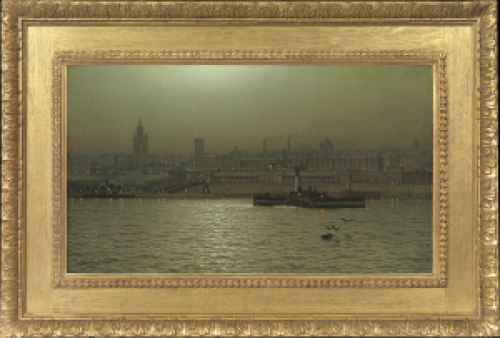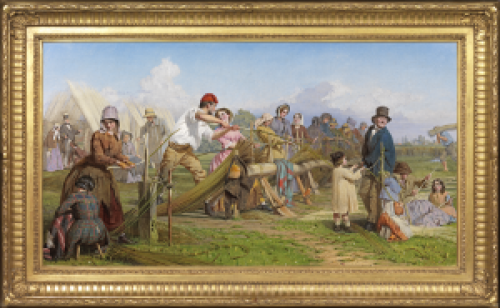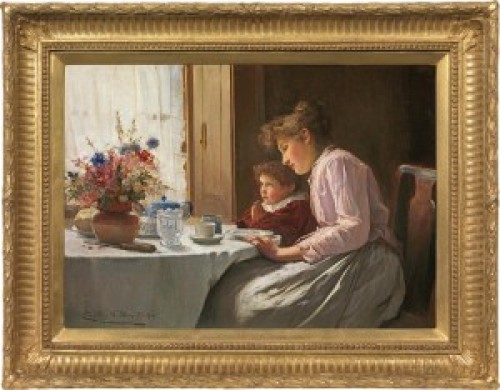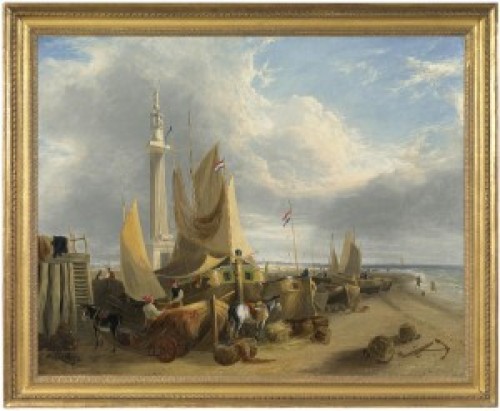ERNEST CROFTS
Ref: CA 129
The Funeral of Her late Majesty Queen Victoria on 2nd February 1901
Signed and dated lower left: E. Crofts 1901.
Oil on canvas: 56 1/8 x 41 ¼ in / 142.6 x 104.8 cm
Frame size: 65 x 50 in / 165.1 x 127 cm
Provenance
Private collection, Europe, acquired circa 1950;
private collection, Europe
Exhibited:
London, Royal Academy, 1903, no.167
Christchurch, New Zealand International Exhibition 1906-7: Fine Art Section, no.42
Ernest Crofts depicts the solemn pageantry of Queen Victoria’s funeral, held on the bitterly cold 2nd of February 1901, at the beginning of a new century that would see upheavals in the old order that the Queen could never have imagined. The funeral procession makes its way up St James’s Street, past the Devonshire Club, hung with black. It will turn west into Piccadilly and then to Paddington, where a train conveyed the Queen to Windsor for the funeral service at St George’s Chapel, Windsor Castle. The coffin is draped in white, as Queen Victoria had decreed. Behind the gun carriage rides King Edward VII, flanked on the left by his brother Prince Arthur, Duke of Connaught and on the right by the German Emperor Wilhelm II, Queen Victoria’s grandson.
Queen Victoria died at Osborne House, Isle of Wight, the home she had created during her happy married years with Prince Albert, on 22nd January 1901. She had reigned for sixty-three years, 216 days, the longest reign of any British monarch before that of Queen Elizabeth II. She desired to be buried as ‘a soldier’s daughter’ and the funeral was to be white. The Queen was dressed in white, wearing her wedding veil, a symbolic reunion with Prince Albert whom she had mourned in black for forty years. The gun carriage bearing the Queen’s coffin is draped in white, pulled by white horses.
Queen Victoria’s body was brought from the Isle of Wight to Gosport on board the Royal Yacht Alberta and conveyed by train to Victoria station, before crossing London to Paddington. Ernest Croft captures the ‘incredibly and immensurably vast’ sea of mourners noted by the novelist Henry James and the glorious uniforms of the troops who line the street. It was the first time that a gun carriage had been used to carry a monarch’s coffin; this State Funeral Gun Carriage has been used at the funeral of every subsequent monarch, most recently at that of Her late Majesty Queen Elizabeth II, on 19th September 2022. At Windsor, a trace on the gun carriage broke, causing the horses to shy. They were quickly unhitched and the carriage was borne to St George’s Chapel by sailors, a tradition which has continued with every State funeral since. After two days’ private lying-in-state, Queen Victoria was buried in the Royal Mausoleum at Frogmore, beside her beloved Albert.
ERNEST CROFTS, RA
Leeds 1847 – 1911 London
Ernest Crofts was a leading historical and military painter. He was born in Leeds in 1847, the son of John Crofts, a manufacturer and lawyer, and his wife Ellen, née Wordsworth. After Rugby School, he studied in Berlin where he was fired with the idea of becoming a painter. Crofts was a pupil in England of Alfred Borron Clay (1831-1868) and also studied in Düsseldorf with Emil Hünten (1827-1902), military and historical painter to the Prussian royal family. Crofts painted some of the actions of the Franco-Prussian War, which he witnessed. He depicted scenes from the English Civil War, including Cromwell at the sign of the Blue Boar, 1883 (Dudley Museum and Art Gallery) and the Napoleonic Wars, for example On the evening of the Battle of Waterloo (Walker Art Gallery, Liverpool).
Crofts exhibited at the Royal Academy from 1874 to 1904, was made ARA in 1878, RA in 1896 and Keeper and Trustee of the RA in 1898. In 1901 he painted Queen Victoria’s funeral and was commissioned by Edward VII to depict the Distribution of medals for the South African Campaign by King Edward VII, Horse Guards Parade, 1901-2 (Royal Collection, on loan to Sandhurst Military Academy). Crofts was meticulous in his research and owned a large collection of military uniforms to aid his compositions. In 1872 he married a fellow artist, Elizabeth Wüsthofen from Düsseldorf; they had one daughter, also Elizabeth. The Crofts lived latterly at Blythburgh in Suffolk. Ernest Crofts died in London in 1911.

























